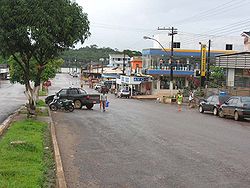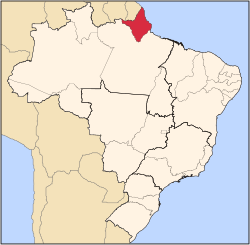Oiapoque
| Oiapoque | |
|---|---|
| Municipality | |
| Município de Oiapoque | |

A street in Oiapoque.
|
|
 Location of Oiapoque in the State of Amapá |
|
 |
|
| Coordinates: 03°50′34″N 51°50′06″W / 3.84278°N 51.83500°WCoordinates: 03°50′34″N 51°50′06″W / 3.84278°N 51.83500°W | |
| Country |
|
| Region | North |
| State |
|
| Founded | 1945 |
| Area | |
| • Total | 22,625 km2 (8,736 sq mi) |
| Elevation | 3 m (10 ft) |
| Population (2008) | |
| • Total | 20,226 |
| • Density | 0.85/km2 (2.2/sq mi) |
| Time zone | UTC-3 (UTC-3) |
| HDI (2000) | 0.738 – medium |
| Website | oiapoque.com.br |
Oiapoque (Oyapock) is a municipality in the north of the state of Amapá, Brazil. Its population is 20,226 and its area is 22,625 square kilometres (8,736 sq mi).Oiapoque is also a major river in the same state, forming the international border with French Guiana. The Oyapock River Bridge, connecting the village with Saint-Georges in French Guiana, was constructed but not opened to pedestrian or vehicle traffic.
Lying on the northern coast of Brazil, Oiapoque is popularly considered the northernmost point of Brazil. The phrase "do Oiapoque ao Chuí" (from Oiapoque to Chuí) means "all of Brazil." However, there are more northerly points in Roraima state such as the municipality of Uiramutã. Oiapoque remains the northernmost coastal city of Brazil, and the northernmost city of Amapá. It occupies more than half of the north border of the state.
The Oiapoque River is said to have been found by Vicente Yáñez Pinzón in the first years of the 16th century. It has been called Japoc, Yapoc, Iapoco, and even Vicente Pinzón River. The name Oiapoque was officially used from 1900, when a territorial dispute between Brazil and France was resolved through Swiss diplomatic arbitration.
At the beginning of the 20th century, the village of Oiapoque hosted a political and criminal concentration camp called Clevelândia. In 1922 an agricultural outpost called the Núcleo Colonial Cleveland was transformed into a camp during the presidency of Arthur Bernardes (1922–1926). Many Brazilian anarchist militants were sentenced to hard labour here. Of the 946 prisoners interned at Clevelândia between 1924 and 1927, 491 died. Many of the survivors returned to São Paulo and Rio de Janeiro permanently sickened with malaria.
...
Wikipedia
